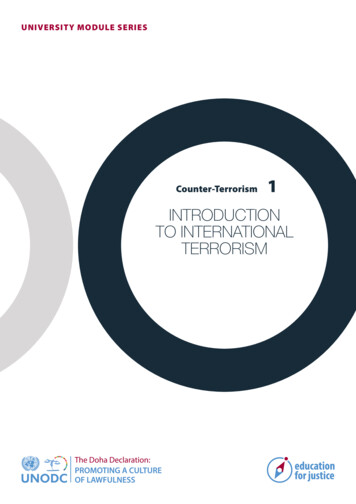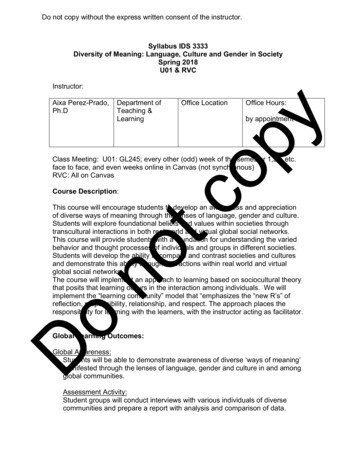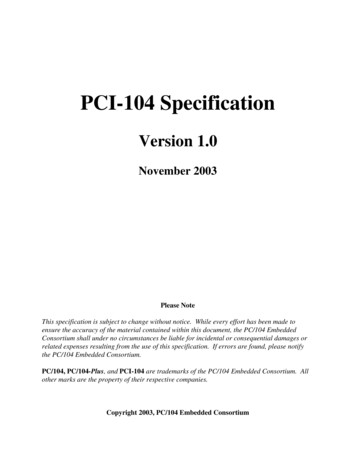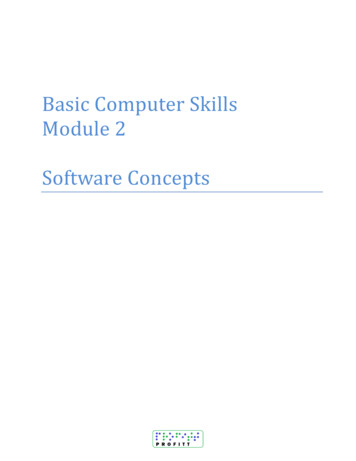
Transcription
UNIVERSITY MODULE SERIESCounter-Terrorism1INTRODUCTIONTO INTERNATIONALTERRORISM
UNITED NATIONS OFFICE ON DRUGS AND CRIMEEDUCATION FOR JUSTICEUNIVERSITY MODULE SERIESCounter-TerrorismModule 1INTRODUCTION TOINTERNATIONAL TERRORISMUNITED NATIONSVienna, 2018
This Module is a resource for lecturers.Developed under the Education for Justice (E4J) initiative of the United Nations Office on Drugs and Crime (UNODC),a component of the Global Programme for the Implementation of the Doha Declaration, this Module forms part of theE4J University Module Series on Counter-Terrorism and is accompanied by a Teaching Guide. The full range of E4Jmaterials includes university modules on Anti-Corruption, Crime Prevention and Criminal Justice, Cybercrime, Firearms,Organized Crime, Trafficking in Persons/Smuggling of Migrants, and Integrity and Ethics, as well as Counter-Terrorism.All the modules in the E4J University Module Series provide suggestions for in-class exercises, student assessments, slidesand other teaching tools that lecturers can adapt to their contexts, and integrate into existing university courses andprogrammes. The Module provides an outline for a three-hour class, but can be used for shorter or longer sessions.All E4J university modules engage with existing academic research and debates, and may contain information, opinionsand statements from a variety of sources, including press reports and independent experts.Terms and conditions of use of the Module can be found on the E4J website. United Nations, August 2018. All rights reserved, worldwide.The designations employed and the presentation of material in this publication do not imply the expression of anyopinion whatsoever on the part of the Secretariat of the United Nations concerning the legal status of any country,territory, city or area, or of its authorities, or concerning the delimitation of its frontiers or boundaries.This publication has not been formally edited.Publishing production: English, Publishing and Library Section, United Nations Office at Vienna.
ContentsINTRODUCTION1KEY ISSUES2A brief history of terrorism3Terrorism in the nineteenth century4The League of Nations and terrorism6The United Nations and terrorism8United Nations designated terrorist groups and targeted sanctions10Terrorist victimization: victims of terrorism11EXERCISES AND CASE STUDIES14POSSIBLE CLASS STRUCTURE16CORE READING17Terrorism17Terrorist victimization17ADVANCED READING18Terrorism18Terrorist victimization19STUDENT ASSESSMENT20Assessment questions20ADDITIONAL TEACHING TOOLS21REFERENCES22Books/e-Books22Book chapters22Cases23Conventions, charters and treaties23Journal/online articles and presentations24United Nations materials24Reports and remarks24iii
IntroductionAlthough the term is not subject to a universally agreed definition, terrorism can be broadlyunderstood as a method of coercion that utilizes or threatens to utilize violence in order tospread fear and thereby attain political or ideological goals. Contemporary terrorist violenceis thus distinguished in law from “ordinary” violence by the classic terrorist “triangle”: Aattacks B, to convince or coerce C to change its position regarding some action or policydesired by A. The attack spreads fear as the violence is directed, unexpectedly, against innocentvictims, which in turn puts pressure on third parties such as governments to change theirpolicy or position. Contemporary terrorists utilize many forms of violence, and indiscriminatelytarget civilians, military facilities and State officials among others.The challenges of countering terrorism are not new, and indeed have a long history. The term“terrorism” was initially coined to describe the Reign of Terror, the period of the FrenchRevolution from 5 September 1793 to 27 July 1794, during which the RevolutionaryGovernment directed violence and harsh measures against citizens suspected of beingenemies of the Revolution. In turn, popular resistance to Napoleon’s invasion of the SpanishPeninsula led to a new form of fighter—the “guerrilla”, which derives from the Spanish wordguerra, meaning “little war” (Friedlander, 1976, p. 52). As a weapon of politics and warfare,however, the use of terrorism by groups can be traced back to ancient times, and as noted byFalk, “in various forms, terrorism is as old as government and armed struggle, and as pervasive”(Falk, 1990, pp. 39, 41). The focus of this module, and of the University Module Series as awhole, is on terrorist violence and the threats carried out by non-State groups and theresponse of the international community, especially States, regional organizations and theUnited Nations system.LEARNING OUTCOMES Understand the semantic and historical development of the word“terrorism”. Analyse the concept and underpinning legal principles of internationalcrimes of terrorism, whether at the national or international level. Explain treaty-based crimes relevant for prosecuting acts of terrorism,whether at the national or international level. Identify and discuss some of the reasons for, and implications of, theabsence of a universally accepted definition of terrorism at the global level. Familiarize students with interdisciplinary perspectives (e.g., victimology).1
2COUNTER-TERRORISMUNIVERSITY MODULE SERIESKey issuesThe purpose of this Module is to introduce students to the key concepts and principles thatunderpin international instruments and institutions concerned with the complex topics ofterrorism and how to counter terrorism, as well as any hard, security-based, responses adoptedby States when confronted with acts of terrorism. When considering the concept of terrorism,it is important to note that as yet, there is no global consensus regarding an agreed definitionof the term “terrorism” for legal purposes (see further Module 4). This Module will alsoprovide a brief overview of modern terrorism and its implications for the internationalcommunity. Regarding the prosecution of the perpetrators of acts of terrorism, it is vital tounderstand how, why and to what extent, the impact of a lack of a universally agreed globallegal definition of the term may have had on the effective investigation and prosecution ofterrorist offences. Principally, prosecuting chargeable crimes must rely on the judicial forumsavailable. A decision to prosecute a “terrorist” offence will depend, among other factors, onlegal and non-legal considerations. Furthermore, the State of custody must decide either toprosecute (as a “terrorist” or an ordinary crime) or to extradite elsewhere for prosecutionpersons accused of serious, transboundary terrorist crimes. Choosing between prosecutingon the grounds of “terrorist” or of ordinary crimes also involves wider issues such as thedistinction between armed and non-armed conflict, the State use of counter-terrorist forceand the return of “terrorists” who have been fighting abroad.Notwithstanding the absence of a globally agreed, legal definition of terrorism, an effectiveand prevention-focused international response to terrorism is highly desirable, particularlyone guided by a normative legal framework and embedded in the core principles of the ruleof law, due process and respect for human rights. Many international and regional legalinstruments already exist which are dedicated to countering and deterring terrorism (seefurther Modules 4 and 5), primarily through the investigation and prosecution of thosesuspected of committing related crimes by means of State criminal justice processes. Whilesuch international and regional instruments provide for effective prevention mechanisms,including interventions targeting specific types of criminal acts (e.g., hostage-taking, thehijacking of planes or ships, terrorist bombings and the funding of terrorism), States implementtheir treaty obligations differently. As a result, criminal justice responses and outcomes ininvestigating and prosecuting terrorism-related crimes may vary between States.Since the terrorist attacks of 11 September 2001, international support for more effectivecounter-terrorism measures and responses has led to greater international cooperation incounter-terrorist matters, and there is certainly evidence of a widespread hardening ofapproaches to the prosecution of “terrorists”. This is important in a context that is witnessingthe increased export and globalization of terrorism by groups such as Al-Qaida and theIslamic State in Syria and the Levant (ISIL, or Da’esh), a trend that shows no sign of abating.In response, States are utilizing a range of counter-terrorism measures, from criminal justice
MODULE 1INTRODUCTION TO INTERNATIONAL TERRORISMmechanisms—which should represent the usual response, including as a means of terrorismprevention—to “harder” security-based measures accompanied by increased militaryspending. Although, as discussed in Module 6, military responses may be entirelyappropriate where the requisite legal criteria are met, such as the threshold of violencenecessary to constitute an armed conflict, these are also accompanied by increasedcomplexities. For example, in most situations “terrorist” groups do not cross the requisitethreshold for the application of international humanitarian law (International LawAssociation, 2010). Yet when States utilize armed force, it can be argued that internationalhumanitarian law should apply (an approach adopted as “policy” by a number of States) tothe treatment and prosecution of captured non-State violent actors, not least becauseinternational humanitarian law mandates strong due process rights and humanitariantreatment of all those placed hors de combat (see further Module 6).The landscape of terrorism and counter-terrorism is complex and sensitive due to these andother factors examined throughout the University Module Series. When considering thefuture of terrorism therefore, it can be helpful first to look backwards, albeit briefly, to themodern origins of the criminal phenomenon referred to today as international ortransboundary terrorism.Together with a brief overview of the history of terrorism, this Module will also consider theevolution of terrorism in the twentieth century. In doing so, where examples are informative,these are drawn from terrorist organizations which have been formally designated as suchwithin the United Nations system, namely Al-Qaida and ISIL (Security Council resolution 1267(1999) and subsequent resolutions). That is not to say that other “terrorist” groups are any lessimportant or that the impact of their criminal activities is any less significant in their areas ofoperation; rather it is reflective of some of the legal and political complexities underlyingmany of the issues examined in this University Module Series, a number of which circle backto the inability of the international community to agree on a universal definition of terrorism.Without this, it is often not possible to reach universal agreement, for instance, regarding thedesignation of “terrorist” groups. For similar reasons, since matters of “terrorist” motivationscan be politically sensitive, the discussion of terrorism throughout the University ModuleSeries is largely framed around related criminal acts and not any underlying ideologies orother motivating factors (e.g., self-determination), consistent with the approach of theinternational community, as reflected within the universal anti-terrorism conventionsexamined in Module 4.A BRIEF HISTORY OF TERRORISMIn terms of targeting, many of the tactical means and methods of modern terrorism have,until relatively recently, followed those utilized between States in their armed conflicts interse. It has been argued specifically that, a century ago, terrorist codes on targeting victimsclosely resembled professional military codes, in that they respected the distinction betweensoldiers and officials on the one hand, and innocent civilians on the other (e.g., the targeted3
4COUNTER-TERRORISMUNIVERSITY MODULE SERIESassassination of Archduke Franz Ferdinand of Austria on 28 June 1914) (Walzer, 1977, pp. 197234). This was the case from approximately the mid-nineteenth century onwards, whenincreasingly industrialized weaponry facilitated a lack of targeting, in the sense that killing theenemy became more indiscriminate and deadly. The industrialized and indiscriminate meansand methods of warfare utilized during the two “total wars” of the twentieth century (e.g., inwidespread disregard of the principle of distinction) effectively taught those who wouldbecome post-war revolutionary terrorists, and who also would adopt more irregular weaponsand forms of fighting, such as urban guerrilla warfare. In the contemporary world,indiscriminate weaponry (e.g., high-level bombing capacities, weapons of mass destruction(WMDs), and so on) is a recurring feature.In terms of terrorist strategy, a useful way to conceptualize the evolution of modern terrorismas a resort to revolutionary violence is provided by David Rapoport’s influential concept ofthe “waves” of terrorism (The Four Waves of Terrorism). For example, one wave is the latenineteenth century/early twentieth century “anarchist wave”. Another is the “anti-colonialwave” (starting with the post-World War I political principle of self-determination, e.g., theAaland Islands arbitration in 1921, and its violent evolution into a legal right after WorldWar II, examples being the Algerian Civil War and the Vietnam War).In turn, the tactics employed in each of these waves often mirrored those utilized betweenStates during armed conflict, not least because demobilized soldiers throughout the ageshave returned to their homes at the end of a war fully trained tactically to utilize force, whilethe name of each terrorist wave reflects its dominant strategic goals. The wave theory furtherreflects that terrorist groups rise and fall, that they can dissolve when no longer capable ofinspiring others to continue with violent resistance to authority, to violently redress one orother grievance, or to protest violently against a lack of political concessions. This point alsosuggests that terrorism and its motivations are clearly impacted by the conditions of andchanges in social and political cultures.In contrast, Parker and Sitter (2016) posit that violent terrorist situations occur around theworld not so much in waves, but because terrorist actors are motivated differentially throughfour goal-oriented strains: socialism, nationalism, religious extremism or exclusionism. Theseunderlying motivators are not chronologically sequential, i.e., one strain dies and a new onearises. Instead, they can work in parallel, and can occasionally overlap, to motivate differentterrorist movements according to their needs.Such academic discourse offers a flavour of some of the discussions and debates that occurwhen seeking to better comprehend or categorize “terrorist” groups. This University ModuleSeries, however, does not take a view regarding what the motivational factors of various nonState actors may or may not be. These are issues that those teaching this or any other parts ofthis University Module Series may wish to explore further within different contexts.TERRORISM IN THE NINETEENTH CENTURYModern terrorism can be traced back to nineteenth century revolutionary radicalism, and, inparticular, the emergence of “anarchist”, “collectivist anarchist” and “anarcho-communist”
MODULE 1INTRODUCTION TO INTERNATIONAL TERRORISMgroups. For example, from the mid-nineteenth century onwards, groups led or influenced bythe Frenchman Pierre-Joseph Proudhon, author of What is Property? (1840), the German KarlMarx, and the Russian Mikhail Bakunin, were promoting one or another anti-establishmentmodel. Within a decade, similar groups had appeared throughout Western Europe, theBalkans and Asia. The German revolutionary Karl Heinzen was the first to articulate the use ofviolence, even mass murder, by individuals to effect political change in his influential 1853pamphlet, Mord und Freiheit, coining the term Freiheitskämpfer or “freedom fighter” in theprocess. However, as these early radicals became disillusioned by their failure to provokewidespread social revolution among the peasantry through traditional means such asdistributing political pamphlets and leaflets urging uprisings and riots to put governmentunder pressure, they turned instead to violence in the hope of forcing political reform and ofundermining the State. In this way, “propaganda by the deed”, as a strategy for political action,became central to the politics of European anarchism (see, for example, Fleming, 1980).The principal violent method of spreading terror utilized by virtually all such groups at thetime was targeted assassination, which not only carried with it serious personal risk but alsothe potential for political martyrdom. The assassination of Czar Alexander II in 1881 by theRussian revolutionary group Narodnaya Volya is emblematic of this period of terrorism.Targeted assassination could be differentiated from ordinary criminal acts, because targetingpersons acting in an official State capacity signified a deep, personal commitment to a “causethat could inspire others, and epitomised the revolutionary ‘code of honour’ by sparinginnocent citizens”. This arguably made terrorist assassination a more humane form of violencethan civil war, since the terrorist’s targeted attack would strike only against State “oppressors”,and would help maintain the low casualty rate of terrorism that was also an advantage of the“propaganda by the deed” strategy (Morozov, 1880, p. 106).Technological developments in the mid and late nineteenth century also played a pivotal rolein the rise of terrorism. The ready availability of dynamite allowed terrorists to perpetrate anddisseminate their deadly acts more widely as propaganda by the deed. The development ofmass communication technologies allowed news, learning, ideas and events to be rapidlycommunicated across long distances, opening up an era of mass communication and ofmigration that was crucial to inspiring groups elsewhere. The invention of the telegraph andthe steam-powered rotary press meant that newspapers could receive messages almostinstantly after transmission from around the world and gave millions of people access toinformation about events virtually as soon as they occurred. New technologies, together withgreater access to educational opportunities, facilitated the migration of agricultural labourersand artisans to urban centres. The development of commercial railways and trans-Atlanticpassage steamers aided groups to travel long distances, and to carry their political sympathiesfurther afield.Although the successful assassination of Czar Alexander II would initially inspire a wave ofanarchist violence that shook Europe and the Americas over the following decades (Zimmer,2009), Russian rebels encouraged and trained a variety of rebel groups who were emergingelsewhere, even when their political aims were vastly different. While anarchists carried outbombings in France, Germany, Italy, Spain and elsewhere, which at times turned into cyclesof retribution between anarchists and the authorities (Zimmer, 2009), Western States5
6COUNTER-TERRORISMUNIVERSITY MODULE SERIESattempted to stem the tide through such legal mechanisms as immigration controls andextradition treaties targeted against “undesirable aliens”. These included a protocol concerningmeasures to be taken against the anarchist movement, signed on behalf of nine States inMarch 1904, and an administrative convention for the exchange of information concerningindividuals considered dangerous to society, signed in October 1905 (Hudson, 1941, p. 862).By the mid-nineteenth century, many extradition treaties exempted fugitives accused of“political offences” or “crimes of a political character” from extradition (Hannay, 1988, p. 116).Only the conservative regimes of Austria, Prussia, Russia, and Naples persisted in advocatingthat ideologically similar nations should use their extradition laws to help suppress eachother’s revolutionaries (Pyle, 1988, pp. 181-182).On 28 June 1914, Gavrilo Princip, a young Serbian nationalist and supporter of the clandestineBlack Hand group, which wished to bring about a Greater Serbia, assassinated the Archdukeof Austria and heir presumptive, Franz Ferdinand, and his wife, in Sarajevo. This eventunleashed a “domino effect” of defensive alliances developed in the pre-war years, leading tothe “total war” of World War I, which irrevocably changed the face of terrorism for the eras tocome. By the end of the war, with the return of fully-trained soldiers to their homes andfamilies, the tactics and methods learned in “total war” between 1914 and 1918 wouldcontinue to haunt States. As revolutionary politics at the local level continued to simmerthroughout the nineteenth century, the continued availability and use of “political offence”exceptions as grounds upon which States might refuse requests by other States for theextradition of persons suspected of having perpetrated violent offences for various ideological,religious or political motives highlighted the difficulties associated with distinguishingcriminal acts of terrorism from criminal acts generally. These definitional issues have continuedto the present day.THE LEAGUE OF NATIONS AND TERRORISMThe 1919 Versailles Peace Treaty between Germany and the Allied Powers that concludedWorld War I precipitated the next phase in the development of modern terrorism. TheCovenant of the League of Nations (the League Covenant) redistributed former German andTurkish colonies and other dependencies through the League mandate system, which wasdesigned to ensure a “mild form of international accountability for [their] administration”(Thullen, 1964, p. 9). Otherwise, standards to help integrate minority peoples in the newStates created after 1919, such as Yugoslavia, were also provided for, and were intended toserve a peace-making function, while deterring transboundary alliances (Veatch, 1983/2010,p. 369). Nonetheless, protected common rights, such as the right to a nationality, the freeexercise of belief, employment and identity, and rights enshrined in the ideals of the mandatesystem and policies on minorities did not apply to the peoples and minorities in the victoriousStates, which later were instead the guarantors of peace and security as a whole, while thevictors also presumably rejected the notion of new colonial acquisitions when declining toannex former colonies and non-governing territories. Overall, the Covenant system of mutualdefence appeared to be designed to favour international security concerns rather than thoseof the rule of law and international law, in the event of a conflict.
MODULE 1INTRODUCTION TO INTERNATIONAL TERRORISMThe twentieth century link between modern terrorism and the ideal of self-determinationarose within the competing ideologies of communist/socialist theory (Lenin, 1914/1972), andthose reflected in a League of Nations Covenant in which there is no express reference to theprinciple of self-determination. In contrast to the rejection of all prior Czarist debts andobligations by the post-war revolutionary Government of the Soviet Union, the United States,under the presidency of Woodrow Wilson, was a strong proponent of the “peoplehood”principle of self-determination (Morgan, 1980, pp. 355-359). However, Wilson did not holdsway on this concept of self-determination at the Versailles conference at which the finalversion of the Covenant was agreed. In addressing the issue of self-determination, article VI ofthe Wilson-Miller draft of the proposed League Covenant provided that: The League of Nations shall require all new states to bind themselves, as a conditionprecedent to their recognition as independent or autonomous states, to accord to allracial or national minorities within their jurisdiction exactly the same treatment andsecurity, both in law and in fact, that is accorded to the racial or national majority oftheir people (Fawcett, 1979, p. 7).Even so, such issues in the era of the League of Nations represented only a number of thefactors to be considered during the formation of new States, whether within the operationalcontext of mechanisms to attain statehood, or as a matter of self-help. When issues relating toself-determination arose early on in the League’s existence during the Aaland Islands disputein 1920 between Sweden and Finland, the League Council appointed the InternationalCommission of Jurists to determine the matter. The Commission concluded that the mererecognition of the principle of self-determination, as made out in a number of treaties, did notcreate a positive rule of the law of nations (Wilson, 1988, p. 57). In part, this was due to theCommittee’s apprehension about creating a precedent for secession, thereby encouraginganarchy. However, a subsequent Committee of Inquiry refined this result by concluding thatif Finland failed to provide the islanders with certain specified guarantees, they would indeedhave a right under international law to a plebiscite, which could have resulted in separationfrom Finland. Nowadays, the Aaland Islands solution is regarded as a precedent for successfulinternational dispute settlement (O’Brien, 2012).In the meantime, the spate of terrorist assassinations continued. By the 1930s, several bilateralagreements referred to the suppression of terrorism, and many extradition treaties containedclauses excluding assassination attempts against Heads of State from the exempted list ofpolitical offences (e.g., Convention on Extradition 1933, article 3(e)). The assassinations ofKing Alexander I of Yugoslavia and the French Minister for Foreign Affairs together inMarseilles on 9 October 1934 brought matters to a head, when the requested extradition ofthe persons accused was refused by Italy on the grounds that the offences were political(Chadwick, 1996). In response, a Committee of Experts was established by the League Councilto draft a Convention on Terrorism for the establishment of an International Criminal Court,which would have jurisdiction over certain acts specified as acts of terrorism in the Convention,and which States Parties were obliged to criminalize within their national laws. Article 1(2)of the Terrorism Convention defines “acts of terrorism” as “criminal acts directed against astate” (1937). Such acts must be “intended or calculated to create a state of terror in the7
8COUNTER-TERRORISMUNIVERSITY MODULE SERIESminds of particular persons, or a group of persons or the general public”. The Convention issilent on the purpose of the fear generated (Chadwick, 1996).Nonetheless, State and regional traditions of asylum, coupled with strong national sympathies,made any differentiation between “terrorist” and “political” offences problematic, and thegranting of asylum remained possible then, as now. Moreover, the 1937 Terrorism Convention,as a creature of its time, had no “international” criminal law to be grounded in, as reflected inarticle 19, which provides that: The present Convention does not affect the principle that, provided the offender is notallowed to escape punishment owing to an omission in the criminal law, thecharacterisation of the various offences dealt with in the present Convention, theimposition of sentences, the methods of prosecution and trial, and the rules as tomitigating circumstances, pardon and amnesty are determined in each country by theprovisions of domestic law.Therefore, the law applicable to any criminal prosecution for acts established as offencesunder the Convention was to be that of the referring, and thus, prosecuting, State.Unfortunately, World War II erupted soon after, and neither convention entered into force.THE UNITED NATIONS AND TERRORISMA recurring feature of discussions, debates and political sensitivities regarding terrorismduring the post-1945 United Nations era have related to issues of terror-violence by so-called“liberation fighters” claiming to be utilizing “direct action” to pursue their right to the selfdetermination of peoples, as they argued is provided for in the United Nations Charter (TreatySeries, vol. 1, no. XVI), articles 1(2) and 55 (see also 1941 Atlantic Charter). The Chartercontextualizes the Organization’s obligation to “develop friendly relations” among nations(not “States”) based on the principles of equal rights and the self-determination of “peoples”.Difficulties with and controversies regarding the practical operation of equal rights and selfdetermination soon arose, including where national liberation agendas stretched far beyondthe narrow confines of the League of Nations mandate system and the protection of minorities.As a consequence, conflicting interpretations of relevant Charter principles and provisionssurrounding self-determination quickly arose and have remained ever since.This Module, as well as the University Module Series as a whole, does not attempt to commenton the accuracy or otherwise of particular legal or political positions. Rather it seeks toprovide an impartial commentary on legal and interdisciplinary approaches to terrorism andcounter-terrorism, by identifying the existence of ongoing debates, where appropriate, inorder to assist students in better comprehending current approaches to the phenomenon ofterrorism and current responses to it by States and intergovernmental organizations, includingthe United Nations system. On issues such as self-determination, including the ongoing“freedom fighter versus terrorist” conundrum, what is important to understand is that theseissues have been, continue and are likely to remain contentious and have implications forissues such as the continuing inability of the international community to agree on a universaldefinition of terrorism with law-making consequences.
MODULE 1INTRODUCTION TO INTERNA
E4J University Module Series on Counter-Terrorism and is accompanied by a Teaching Guide. The full range of E4J materials includes university modules on Anti-Corruption, Crime Prevention and Criminal Justice, Cybercrime, Firearms, Organized Crime, Trafficking in Persons/Smuggling of Migrants, and Integrity a











